This article was originally published in The Hill.
Years of hot, dry conditions and population growth across the Southwest have brought painful reductions in Colorado River water flow allocations to Arizona, California, Nevada, and Mexico. Based on a 1920s multi-state pact, the Department of the Interior sounds an alarm when the river’s reservoirs fall to extremely low levels, leaving states with no choice but to severely cut their water use, limiting consumption by agriculture, industry, and citizens.
At present, whatever water one state gets, another can expect to lose. And each state has its own body of water law that generally gives priority to historic withdrawal patterns. That body of law is important, but unfortunately, the times have changed. Maybe we should look at some past experiences with extreme water scarcity and consider institutional changes that could make things better for people in the dry southwestern states.
What if, for example, there were clearly established pathways for an Arizona community to profit by replacing plans for its new, beautifully maintained golf course in favor of a “browner” course and selling the water foregone to California farmers? Or, instead of a water district paying homeowners with tax money to plow up their lush lawns—the largest “irrigated crop” in America—homeowners could sell grandfathered lawn rights to other users who value the water more?
As things stand today, there is no institutional arrangement enabling any state or large water-using entity to trade with another. No regional market where water rights are priced or otherwise valued in a way that fully leverages economic incentives to balance demand with diminishing supply and pays for creative ways to conserve.
Western water scarcity is nothing new, and the current situation and its inevitable mandates have been long in the making. Fortunately, there are past lessons to consider. People facing other water scarcity situations have managed to turn perpetual crises where no one was winning into situations not unlike those we use to manage other scarce resources like land, labor, and capital.
Consider the Ruhr River Basin in the late 19th century. At the time, the river passed through the world’s most heavily industrialized region, an area centered on Essen in East Prussia. Production of coal, steel, and chemicals predominated. Population growth had exploded. Heavy industrial discharge and periods of drought and low river flows created water shortages and typhoid epidemics.
Industrial and community leaders decided to do something about it. In 1899, they formed a reservoir association, and in 1913, they incorporated the river and formed the Ruhrverband, a river basin association empowered to manage all aspects of river use.
In effect, the new association became the owner. It first added dams and reservoirs to ease the low-flow situation. It then established prices for any withdrawal from the river, whether for drinking or industrial purposes. It set prices for discharges into the river based on chemical and biological characteristics. The revenues paid to improve the river basin. Discharges known to be harmful to fish and other water life were not allowed at any price. In time flows became more dependable, and the river and the land nearby became more valuable assets.
The king of Prussia then encouraged the incorporation of other rivers. Competing river basin associations charged prices for their own water withdrawal and use. Competition among the river managers led to water quality innovations that lowered the cost of improvements and increased the supply of water for all users. Typhoid problems ended.
Now fast forward to the 20th century and the Ohio River. Like the Ruhr, the area contained growing industrial cities and little concern about sewage and industrial discharge. Downstream Cincinnati’s protests went unheeded until gastroenteritis outbreaks traveled upstream. In 1948, with congressional approval, the Ohio River Sanitation Commission was formed, bringing cooperation and coordination across the eight member states. The river flourished.
What of a desert river like the Colorado? Its water is too precious to treat as a common-access resource where those who get there first get first dibs, or where rigid command-and-control rules for sharing can’t keep up with a diminished flow and burgeoning population. If allocation cutbacks are to be made, why not create a more powerful incentive for water users to either reduce consumption themselves or pay another user to do so?
The multistate Colorado River basin forms a biological unit. It’s high time to form a corresponding political-administrative unit. Lessons from the past may help to improve the situation and make scarcity a prelude to plenty.




